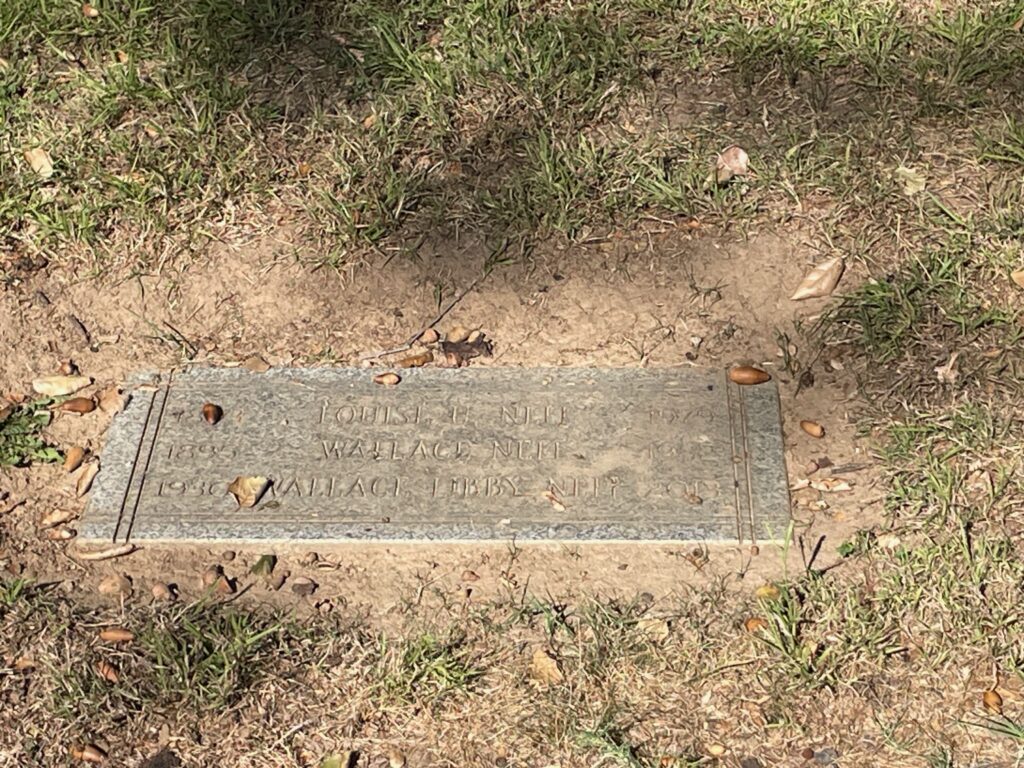Erik Visits an American Grave, Part 1,562
This is the grave of Wallace Neff.

Born in 1895 in La Mirada, California, Edwin Wallace Neff grew up super rich. His grandfather was Andrew McNally, i.e., Rand-McNally. His father founded the town. He grew up in the richest neighborhood in southern California. Then in 1906, the family decided to just live in Europe, so he spent the rest of his childhood touring the big cities of the continent, only returning to the U.S. in 1914, with the onset of World War I.
So I guess with that background, it’s not totally surprising that Neff decided to go into architecture, though it might have been even less surprising for him to just go into nothing and be rich. In any case, despite his wealth, he actually was quite ambitious and hard-working. He started studying under the architect Ralph Adams Cram in Massachusetts and then came back to California to work in the Spanish Revival. In fact, no one did more in the U.S. to promote this style of architecture than Neff. He had fallen in love with Spain when he was in Europe and wanted to build up Los Angeles in its model. His first major work was his family’s own church, St. Elizabeth of Hungary Roman Catholic Church in Altadena, California. Even without looking at it, you know what it looks like more or less–the big bell tower, the arches, the terra cotta tiles, the stucco on concrete, the big view of the San Gabriel Mountains. I haven’t seen this building myself, but this style is so ubiquitous in the imagination (if just because so much of our cultural products are shot in LA) that it is just iconic.
In 1925, Neff designed Pickfair, the famous house where Douglas Fairbanks and Mary Pickford lived. It was an old country hunting lodge. The actors wanted it redone, not in the California style, but in the Tudor style. Well, he could do that too. The house became the most famous home in Hollywood, the site of endless parties and fun and people loved the work. It remained iconic, owned for awhile by Lakers owner Jerry Buss, until Pia Zadora of all goddamn people bought it and tore it down in 1990.
But Neff really remained the king of the California style. This took those Spanish and Islamic elements and combined them with French, Italian, and really whatever else. Perfect for the United States really. He was the guy you wanted designing the home if you could afford him. Quite a few of the big Hollywood mansions of the era are his designs. One of the more famous is the Frederic March house, designed for the actor, that was later the home of Brad Pitt and Jennifer Aniston when they were married. Evidently, Pitt considers himself something of an architectural aficionado and so there was actual speculation over what kind of house they would buy, with a lot of assumptions that it would be a modernist home, but no. Pitt liked Neff’s work. The gigantic house, named Misty Mountain, that he designed for the director Fred Niblo, was later owned by Rupert Murdoch (gross). Long after his death, actors wanted to buy old Neff houses. Bob Newhart bought one. So did Madonna and Guy Ritchie during their extremely stable and unproblematic marriage. Diane Keaton owns one too.
Neff was very much an architect for the elite, but he wasn’t only an architect for the elite. He actually proved quite influential in housing in the developing world. He was interested in low-cost, mass-produced housing in the years after World War II. He created what he called an airform house, sometimes called a bubble house, which was a domed design made of reinforced concrete raised through an inflatable balloon (don’t ask me how that would work). It never really was popular in the U.S., where postwar housing went in a different direction. But leaders in nations such as Egypt and Brazil bought into it as a way to mass-produce inexpensive housing projects. Later in life, he also moved more toward modernism in his work. Some of his later works are pretty well-renowed modernist homes, including one he designed for Groucho Marx.
But overall, Neff’s legacy is building extremely expensive houses in a romantic style for the Hollywood elite of a half-century of that city. Of this, the real estate agent Barry Sloane told the New York Times in 2001,
”Of all the historical revival architects who worked in that medium, he had this wonderful theatrical flair, and that’s what people love. ‘The frivolity, the touches he did. He was a master of scale and proportion. Madonna’s old house has two of the most well-proportioned public rooms as I’ve seen anywhere. If you were made to wait and the pope walked in, you would not be surprised. There’s a classical proportion; you could be in Rome. He nailed it. It’s a transcendent performance.”
These houses were perfect for people looking how to spend their money. Early Hollywood was a lot of poor kids who now were the biggest stars in the world at the very moment they were creating the idea of the modern celebrity. So they wanted the biggest, most ridiculous homes possible, no expenses turned down. That is what Wallace Neff provided them.
Neff worked up until about 1970, when he retired. The last years were tough on his health. He died in 1982 of pneumonia but really of everything. He was 87 years old.
Wallace Neff is buried in Mountain View Cemetery, Altadena, California.
If you would like this series to visit other architects and designers, you can donate to cover the required expenses here. Ruth Maxon Adams is in New Haven, Connecticut and Elizabeth Ayer is in Tumwater, Washington. Previous posts in this series are archived here and here.


